Papers by Wolfgang Willner
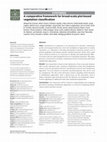
by Joerg Ewald, Sebastian Schmidtlein, Jorge Henrique Capelo Gonçalves, Robert Peet, Jean-paul Theurillat, Don Faber-langendoen, Scott Franklin, Wolfgang Willner, Honza Roleček, Javier Loidi, Flavia Landucci, Ladislav Mucina, François Gillet, and Z. Botta-dukát Aims: Classification of vegetation is an essential tool to describe, understand, predict and mana... more Aims: Classification of vegetation is an essential tool to describe, understand, predict and manage biodiversity. Given the multiplicity of approaches to classify vegetation, it is important to develop international consensus around a set of general guidelines and purpose-specific standard protocols. Before these goals can be achieved, however, it is necessary to identify and understand the different
choices that aremade during the process of classifying vegetation. This paper presents a framework to facilitate comparisons between broad-scale plot-based classification approaches.
Results: Our framework is based on the distinction of four structural elements (plot record, vegetation type, consistent classification section and classification system) and two procedural elements (classification protocol and classification approach). For each element we describe essential properties that can be used for comparisons. We also review alternative choices regarding critical decisions of classification approaches; with a special focus on the procedures used to define vegetation types from plot records. We illustrate our comparative framework by applying it to different broad-scale classification approaches.
Conclusions: Our framework will be useful for understanding and comparing plot-based vegetation classification approaches, as well as for integrating classification systems and their sections.
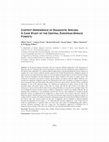
In the phytosociological literature, there are numerous different approaches to the designation o... more In the phytosociological literature, there are numerous different approaches to the designation of diagnostic species. Frequently, this results in discrepancies between the lists of diagnostic species published for one and the same community. We examined different approaches to determining diagnostic species using as an example Picea abies forests within the broader context of all Central European forests. Diagnostic species of spruce forests were determined from a data set of 20,164 phytosociological relevés of forests from the Eastern Alps, Western Carpathians, and the Bohemian Massif, which included 3,569 relevés of spruce forests. Phi coefficient of association was used to measure species fidelity, and species with the highest fidelities were considered as diagnostic. Diagnostic species were determined in four ways, including (A) comparison of spruce forests among the three mountain ranges, (B) comparison between spruce forests and other forests, performed separately in each of the mountain ranges, (C) simultaneous comparison of spruce forests of each of the mountain ranges with spruce forests of the other two ranges and with the other forests of all ranges, (D) comparison of spruce forests with the other forests, using pooled data sets from the three mountain ranges. The sets of diagnostic species of spruce forests yielded in comparisons A and B were sharply different; the set resulting from comparison C was intermediate between the first two and comparison D resulted in similar diagnostic species as comparison B. In comparison A, spruce forests of the Eastern Alps had a number of diagnostic species, while the spruce forests of the other two mountain ranges had only few diagnostic species. In comparison B, by contrast, the number and quality of diagnostic species decreased from the Bohemian Massif to the Eastern Alps. This exercise points out that lists of diagnostic species published in phytosociological literature are dependent on the context, i.e. the underlying data sets and comparisons: some of these lists are useful for identification of vegetation units at a local scale, some others for distinguishing units within a narrowly delimited community type over a large area. The thoughtless application of published lists of diagnostic species outside of the context for which they were intended should therefore be avoided.
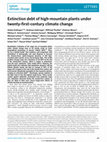
Nature Climate Change, 2012
Quantitative estimates of the range loss of mountain plants under climate change have so far most... more Quantitative estimates of the range loss of mountain plants under climate change have so far mostly relied on static geographical projections of species' habitat shifts 1-3 . Here, we use a hybrid model 4 that combines such projections with simulations of demography and seed dispersal to forecast the climate-driven spatio-temporal dynamics of 150 highmountain plant species across the European Alps. This model predicts average range size reductions of 44-50% by the end of the twenty-first century, which is similar to projections from the most 'optimistic' static model (49%). However, the hybrid model also indicates that population dynamics will lag behind climatic trends and that an average of 40% of the range still occupied at the end of the twenty-first century will have become climatically unsuitable for the respective species, creating an extinction debt 5,6 . Alarmingly, species endemic to the Alps seem to face the highest range losses. These results caution against optimistic conclusions from moderate range size reductions observed during the twenty-first century as they are likely to belie more severe longer-term effects of climate warming on mountain plants.
Journal of Vegetation Science, 2009
Question: How different are lists of diagnostic species of vegetation units, derived using variou... more Question: How different are lists of diagnostic species of vegetation units, derived using various fidelity measures, in different contexts and with presence/absence versus cover data?
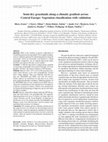
Journal of Vegetation Science, 2007
Question: What is the variation in species composition of Central European semi-dry grasslands? C... more Question: What is the variation in species composition of Central European semi-dry grasslands? Can we apply a trainingand-test validation approach for identifying phyto socio logical associations which are floristically well defined in a broad geographic comparison; can we separate them from earlier described associations with only a local validity? Location: A 1200 km long transect running along a gradient of increasing continentality from central Germany via Czech Republic, Slovakia, NE Austria, Hungary to NW Romania. Methods: Relevés with > 25% cover of Brachypodium pinna tum and/or Bromus erectus were geographically selected from a larger database. They were randomly split into two data sets, TRAINING and TEST, each with 422 relevés. Cluster analysis was performed for each data set on scores from significant principal coordinates. Different partitions of the TRAINING data set were validated on the TEST data set, using a new method based on the comparison of % frequencies of species occurrence in clusters. Clusters were characterized by statistically defined groups of diagnostic species and values of climatic variables. Results: Species composition changed along the NW-SE gradient and valid clusters were geographically well separated. Optimal partition level was at 11 clusters, six being valid: two clusters Germany and the Czech Republic corresponded to the Bromion erecti; two clusters from the Czech Republic and Hungary to the Cirsio-Brachypodion, and two clusters were transitional between these two alliances.
Global Ecology and Biogeography, 2014
Aim Phylogenetic diversity patterns are increasingly being used to better understand the role of ... more Aim Phylogenetic diversity patterns are increasingly being used to better understand the role of ecological and evolutionary processes in community assembly. Here, we quantify how these patterns are influenced by scale choices in terms of spatial and environmental extent and organismic scales.
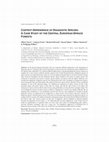
Folia Geobotanica, 2002
In the phytosociological literature, there are numerous different approaches to the designation o... more In the phytosociological literature, there are numerous different approaches to the designation of diagnostic species. Frequently, this results in discrepancies between the lists of diagnostic species published for one and the same community. We examined different approaches to determining diagnostic species using as an example Picea abies forests within the broader context of all Central European forests. Diagnostic species of spruce forests were determined from a data set of 20,164 phytosociological relevés of forests from the Eastern Alps, Western Carpathians, and the Bohemian Massif, which included 3,569 relevés of spruce forests. Phi coefficient of association was used to measure species fidelity, and species with the highest fidelities were considered as diagnostic. Diagnostic species were determined in four ways, including (A) comparison of spruce forests among the three mountain ranges, (B) comparison between spruce forests and other forests, performed separately in each of the mountain ranges, (C) simultaneous comparison of spruce forests of each of the mountain ranges with spruce forests of the other two ranges and with the other forests of all ranges, (D) comparison of spruce forests with the other forests, using pooled data sets from the three mountain ranges. The sets of diagnostic species of spruce forests yielded in comparisons A and B were sharply different; the set resulting from comparison C was intermediate between the first two and comparison D resulted in similar diagnostic species as comparison B. In comparison A, spruce forests of the Eastern Alps had a number of diagnostic species, while the spruce forests of the other two mountain ranges had only few diagnostic species. In comparison B, by contrast, the number and quality of diagnostic species decreased from the Bohemian Massif to the Eastern Alps. This exercise points out that lists of diagnostic species published in phytosociological literature are dependent on the context, i.e. the underlying data sets and comparisons: some of these lists are useful for identification of vegetation units at a local scale, some others for distinguishing units within a narrowly delimited community type over a large area. The thoughtless application of published lists of diagnostic species outside of the context for which they were intended should therefore be avoided.
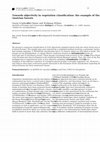
Plant Ecology, 2003
We present a numerical classification of 2145 objectively sampled relevés from the entire forest ... more We present a numerical classification of 2145 objectively sampled relevés from the entire forest area of Austria (Central Europe). The sample sites were selected by a combined method involving a systematic matrix and stratified random sampling. A TWINSPAN classification led to 32 clusters which are described in detail. Three main groups can be distinguished: (1) Alpine-dinaric coniferous forests on carbonate soils, (2) Coniferous forests on acid soils and (3) Deciduous forests. These groups correspond with accuracy to the classes Erico-Pinetea, Vaccinio-Piceetea and Querco-Fagetea in the traditional Braun-Blanquet system. Thus, the value of the Braun-Blanquet approach is supported by more or less objective sampling and numerical classification methods. The assumption of the objective existence of ecological species groups is strongly supported, too. Moreover, our results may help to solve some controverse points discussed in the European forest classification regarding the delimination between the three mentioned classes.

Phytogeographical evidence for post-glacial dispersal limitation of European beech forest species
Ecography, 2000
ABSTRACT The post-glacial migration of European beech Fagus sylvatica has been addressed by many ... more ABSTRACT The post-glacial migration of European beech Fagus sylvatica has been addressed by many studies using either genetic or fossil data or a combination of both. In contrast to this, only little is known about the migration history of beech forest understorey species. In a review of phytosociological literature, we identified 110 plant species which are closely associated with beech forest. We divided the distribution range of European beech forests into 40 geographical regions, and the presence or absence of each species was recorded for each region. We compared overall species numbers per region and numbers of narrow-range species (species present in <10 regions). A multiple regression model was used to test for the explanatory value of three potential diversity controls: range in elevation, soil type diversity, and distance to the nearest potential refuge area. A hierarchical cluster analysis of the narrow-range species was performed.The frequency of range sizes shows a U-shaped distribution, with 42 species occurring in <10 regions. The highest number of beech forest species is found in the southern Alps and adjacent regions, and species numbers decrease with increasing distance from these regions. With only narrow-range species taken into consideration, secondary maxima are found in Spain, the southern Apennines, the Carpathians, and Greece. Distance to the nearest potential refuge area is the strongest predictor of beech forest species richness, while altitudinal range and soil type diversity had little or no predictive value. The clusters of narrow-range species are in good concordance with the glacial refuge areas of beech and other temperate tree species as estimated in recent studies. These findings support the hypothesis that the distribution of many beech forest species is limited by post-glacial dispersal rather than by their environmental requirements.
Ecography, 2010
In as much as the elevation gradient in species composition is often thought to be driven by the ... more In as much as the elevation gradient in species composition is often thought to be driven by the corresponding temperature gradient, species ranges are both expected and predicted to shift upward in response to climate warming. Indeed, there are numerous reports of species moving towards higher elevations in response to the rising temperatures for both animals (Konvicka et al. intuitive expectation of rising elevational ranges as a consequence of a warming climate, ecologists have primarily focused on elaborating on the mechanisms and consequences of such upslope shifts including : 1) biotic attrition in the lowland tropics, 2) gaps between current and projected elevational ranges (range-shift gaps), and 3) mountaintop extinctions in the long-term.
Applied Vegetation Science, 2008
Question: Are there effects of long-term deposition of airborne nitrogen and sulphur on the fores... more Question: Are there effects of long-term deposition of airborne nitrogen and sulphur on the forest floor vegetation from permanent plots collected in 1993 compared to 2005. Location: Northern limestone Alps in Austria.
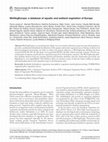
by Andraž Čarni, Flavia Landucci, Kateřina Šumberová, daniela gigante, Úna Fitzpatrick, PANAYOTIS DIMOPOULOS, Els De Bie, Jazep Stepanovich, S. Radulovic, Marcela Řezníčková, Claudia Bita-Nicolae, Rišo Hrivnák, E. Papastergiadou, Csiky János, Wolfgang Willner, and Борис Тетерюк WetVegEurope is a research project (http://www.sci.muni.cz/botany/vegsci/wetveg) whose goal is to... more WetVegEurope is a research project (http://www.sci.muni.cz/botany/vegsci/wetveg) whose goal is to
provide a synthesized formalized classification of the aquatic and marsh vegetation across Europe at the level of
phytosociological associations. In order to achieve the project objective, a WetVegEurope database has been
created (GIVD ID: EU-00-020, http://www.givd.info/ID/EU-00-020), which currently contains 375,212 vegetation
plots of aquatic, marsh and wet vegetation types from 33 European countries. The WetVegEurope database
includes datasets from pre-existing national and thematic databases and also 10,616 plots previously not
digitalized or even unpublished. This database offers an extensive source of data for future studies on aquatic
and marsh plant species and vegetation types at the European scale.
Phytosociological studies by Wolfgang Willner
A historical overview of the phytosociological method in Europe is presented. Some methodological... more A historical overview of the phytosociological method in Europe is presented. Some methodological and procedural differences in the application of the Braun-Blanquet approach, from the selection of the sampling plots to the assignment of relevés to existing or newly described units, are briefly compared. The main advantages and limitations of the phytosociological vegetation classification are reviewed and discussed, also in light of their applications for vegetation mapping and monitoring.








Uploads
Papers by Wolfgang Willner
choices that aremade during the process of classifying vegetation. This paper presents a framework to facilitate comparisons between broad-scale plot-based classification approaches.
Results: Our framework is based on the distinction of four structural elements (plot record, vegetation type, consistent classification section and classification system) and two procedural elements (classification protocol and classification approach). For each element we describe essential properties that can be used for comparisons. We also review alternative choices regarding critical decisions of classification approaches; with a special focus on the procedures used to define vegetation types from plot records. We illustrate our comparative framework by applying it to different broad-scale classification approaches.
Conclusions: Our framework will be useful for understanding and comparing plot-based vegetation classification approaches, as well as for integrating classification systems and their sections.
provide a synthesized formalized classification of the aquatic and marsh vegetation across Europe at the level of
phytosociological associations. In order to achieve the project objective, a WetVegEurope database has been
created (GIVD ID: EU-00-020, http://www.givd.info/ID/EU-00-020), which currently contains 375,212 vegetation
plots of aquatic, marsh and wet vegetation types from 33 European countries. The WetVegEurope database
includes datasets from pre-existing national and thematic databases and also 10,616 plots previously not
digitalized or even unpublished. This database offers an extensive source of data for future studies on aquatic
and marsh plant species and vegetation types at the European scale.
Phytosociological studies by Wolfgang Willner
choices that aremade during the process of classifying vegetation. This paper presents a framework to facilitate comparisons between broad-scale plot-based classification approaches.
Results: Our framework is based on the distinction of four structural elements (plot record, vegetation type, consistent classification section and classification system) and two procedural elements (classification protocol and classification approach). For each element we describe essential properties that can be used for comparisons. We also review alternative choices regarding critical decisions of classification approaches; with a special focus on the procedures used to define vegetation types from plot records. We illustrate our comparative framework by applying it to different broad-scale classification approaches.
Conclusions: Our framework will be useful for understanding and comparing plot-based vegetation classification approaches, as well as for integrating classification systems and their sections.
provide a synthesized formalized classification of the aquatic and marsh vegetation across Europe at the level of
phytosociological associations. In order to achieve the project objective, a WetVegEurope database has been
created (GIVD ID: EU-00-020, http://www.givd.info/ID/EU-00-020), which currently contains 375,212 vegetation
plots of aquatic, marsh and wet vegetation types from 33 European countries. The WetVegEurope database
includes datasets from pre-existing national and thematic databases and also 10,616 plots previously not
digitalized or even unpublished. This database offers an extensive source of data for future studies on aquatic
and marsh plant species and vegetation types at the European scale.